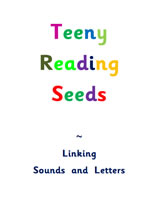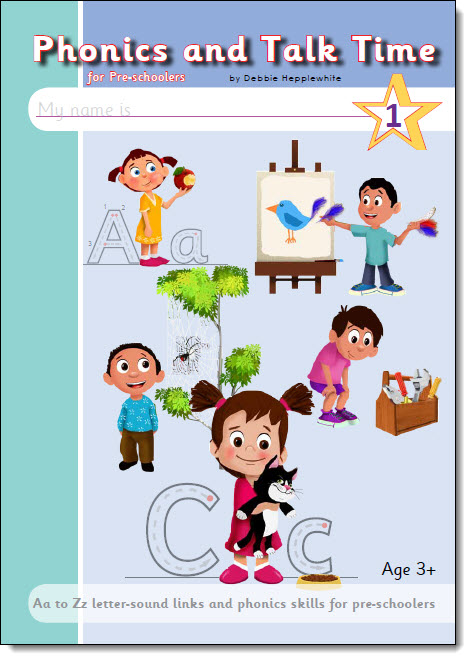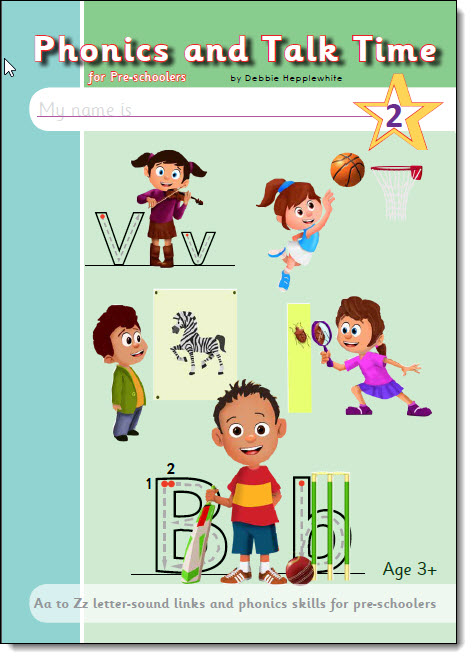Teeny Reading Seed resources
Most of the resources on this page are PDFsand can be viewed/downloaded by clicking on the red ‘Download’ button to the right of the description.
Your Phonics and Talk Time ebooks can be accessed by clicking the links at the bottom of this page.
20 page printable booklet
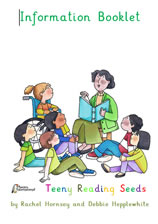
INFORMATION BOOKLET – TEENY READING SEEDS
Information about the alphabetic code and phonics skills and how adults can help young learners make focused links between spoken language and print for reading, spelling and handwriting – building on their daily life, play, book and spoken language experiences.
26 sheets of A4
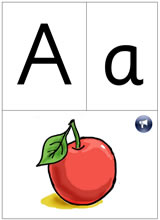
AUDIO‐VISUAL RESOURCE of the 26 upper case and 26 lower case letter shapes and their corresponding sounds.
Listen for the focus sounds in their key picture‐words.
Use this resource online. Click on the speaker icon to hear the sounds and spoken words.
1 sheet of A4
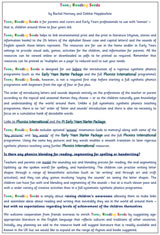
TEENY READING SEEDS RATIONALE
A brief introduction to the thinking behind Teeny Reading Seeds.
4 sheets of A4
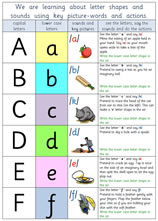
LETTERS, KEY PICTURE‐WORDS AND OPTIONAL ACTIONS CHART
Use in your planning file.
You can also use this for visual display on a main wall. You may want to enlarge each A4 sheet to A3 in a pre‐school or school context.
8 sheets of A4
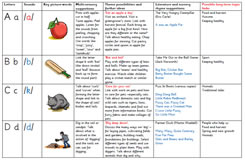
THEMED SUGGESTIONS INCLUDING RHYMES AND LITERATURE
These general suggestions might be helpful for your overarching curriculum. Please note that no ‘order’ is suggested in this planning. You can introduce any letters and sounds in any order according to what is topical in your context.
2 sheets of A4
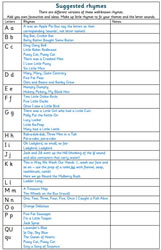
LIST OF SUGGESTED RHYMES AND SONGS
Most of these suggestions are well‐known traditional rhymes and songs. Many will be found in children’s literature.
Try making up some rhymes and songs of your own – along with your child or class.
15 sheets of A4
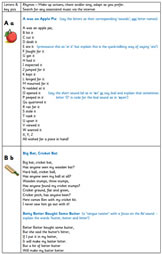
WORDS OF SUGGESTED RHYMES AND SONGS
Make up actions, chant and/or sing, adapt as your prefer. Search for any associated music via the internet.Each colour-range is 13 sheets of A4
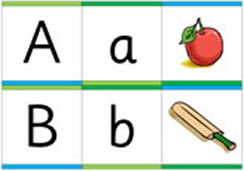
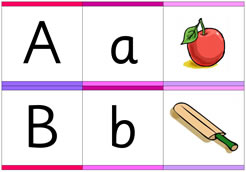
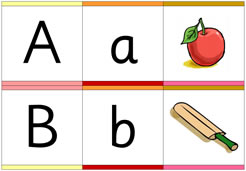
ALPHABET FRIEZE, POSTERS AND FLASH CARDS:
Aa Bb Cc ALPHABET FRIEZE – choose your favourite colour range
Print your choice of colour to your preferred size. Cut in half horizontally to create a frieze for bedroom walls or preschool display. Note that each capital letter is displayed in its own box to avoid confusion as your child progresses to learning about the role of two or more letters together as letter pairs and groups (such as ‘ck’, ‘sh’, ‘ee’, ‘oo’ and ‘igh’) which are code for the smallest sounds of speech (as in ‘d‐uck’, ‘sh‐ee‐p’, ‘m‐oo‐n’ and ‘n‐igh‐t’).
Please note that Phonics International Ltd provides free, full alphabetic code charts which illustrate the relationship between the sounds we can identify in our English words with their many spelling alternatives. The Phonics International programme then provides all the resources which support the teaching and learning of all the letter/ssound correspondences for both reading and spelling.
26 sheets of A4
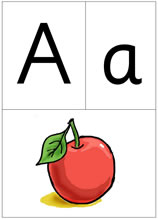
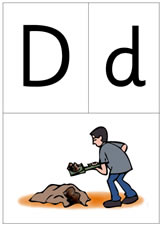
Aa Bb Cc ALPHABET POSTERS, FLASH CARDS OR CARDS FOR MATCHING GAME
Print to your preferred size for visual wall display POSTERS, and/or FLASH CARDS, and/or CARDS MATCHING GAME.
For FLASH CARDS or CARDS MATCHING GAME, laminate or stick on card (or print on card) to create durable cards.
You can cut up the elements on the cards to create “See the letters, say the sounds” or “Hear the sounds and point to the letters” (or air‐write the letter shapes) – and for matching the elements (match capital letters with lower case letters and match to the key pictures).
Please note: When demonstrating to your child how to ‘airwrite’ the letter shapes, always face in the same direction as your child – not opposite your child. Then form the letter shapes in the air with the same writing hand as your child. So, if you are confident that your child is left‐handed, then demonstrate using your left hand in the air.
27 sheets of A4
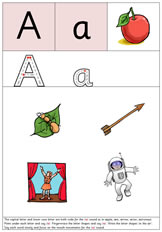

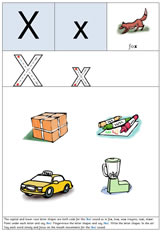
Aa Bb Cc ALPHABET POSTERS WITH LETTER FORMATION AND EXTRA PICTURES
These posters have clear distinctions between the capital letter and lower case letter shapes to avoid confusion with letter groups.
Children see the position of letters on writing lines and learn that letters are formed in special ways – with special starting points and directionality.
These posters can be used in many ways – for example, as posters on walls, and/or made into permanent ‘browse’ books (print double‐sided, laminate and punch holes to put in ring binders – or put printed paper into plastic sleeves).
Use them as a form of ‘activity sheet’ – children can say the sounds and the key picture‐word, finger‐trace and pencil trace inside the letter shapes, say the other picture‐words and think about the focus sound in those words, draw or cut out and glue the pictures and letter tiles and write the letter shapes in their own alphabet books or on paper.
27 sheets of A4
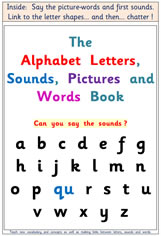

RESOURCES FOR LEARNERS TO USE:
THE ALPHABET LETTERS, SOUNDS, PICTURES AND WORDS BOOK
Use this resource flexibly: Select one page at a time with the focus letter and sound as you need it. Look at this with your child, or children, online – or print as a single sheet if you prefer.
You could print all the sheets and make them up into a book to look at the pages in any order. Staple the sheets together or put the sheets back‐to‐back into a file with transparent sleeves to create a durable ‘book’ for browsing and/or for discussing the contents in more detail.
This book can help not only with linking the first sounds of the picture‐words with the upper and lower case letter shapes – but also with developing your child’s speaking and listening skills and building up vocabulary (that is, learning new words and their meanings for general comprehension).
You could also use selected sheets for your child to cut out the pictures and glue them in his or her own ‘scrap book’, or display, of focus sounds.
26 sheets of A4

COLOURING SHEETS: a to z lower case letters and key pictures to colour
Select and print the sheet for the focus letter and sound. Remember that you can print in smaller sizes (by selecting multiples per page as your printing option). Finger‐track the letter shape whilst saying the sound that the letter is code for and not the letter name – that is /a/ as in apple, and not /ai/. Say the key picture‐word aloud and listen for the first sound (or the last blended sound /ks/ for the word ‘fox’). Colour the letter shape and colour the key picture. Your child, or children, can also add to the picture (for example, draw other things with the same sound such as ‘ants’ on the ‘apple’ sheet – or add a variety of insects on the ‘i insect’ sheet).
You could print all the COLOURING SHEETS to make up booklets for your child, or children, to colour and keep for reference.
26 sheets of A4
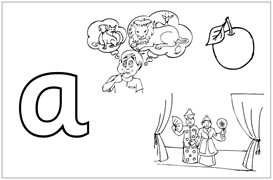
COLOURING SHEETS: a to z lower case letters and three pictures to colour
As above but with three picture‐words to colour.
Can your child, or children, think of further things associated with the focus sound?
26 sheets of A4
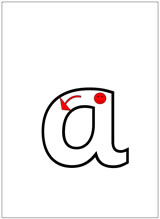
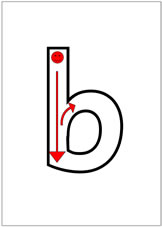
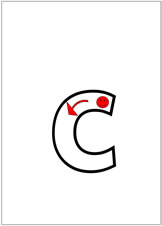
LOWER CASE LETTERS FORMATION with ‘smiley faces’ starting points and direction arrows
Print to your preferred size. Laminate for a permanent preschool teaching and learning resource – or use as a smaller paper‐based resource for your child’s build‐up file of activities.
26 sheets of A4
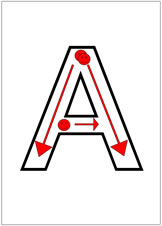
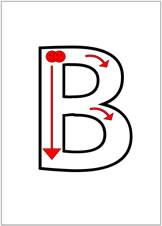
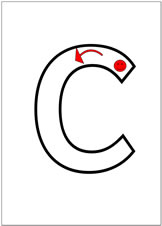
CAPITAL LETTERS FORMATION with ‘smiley faces’ starting points and direction arrows
Print to your preferred size. Laminate for a permanent preschool teaching and learning resource – or use as a smaller paper‐based resource for your child’s build‐up file of activities.
Please note that many teachers prefer letter formation (handwriting) to focus on lower case letter shapes at first. It is important, however, that your child learns that both capital letters and lower case letters are code for the same sounds. This means, for example, that A is code for the same sound as a ‐ as in Ann, or Apple or apple.
26 sheets of A4
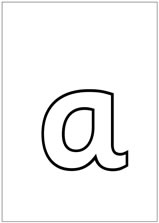
HOLLOW LOWER CASE LETTER SHAPES
Lower case letter shapes for various art and craft activities.
Reduce size by setting multiples per page on your printer or enlarge to A3 by photocopying if required.
26 sheets of A4
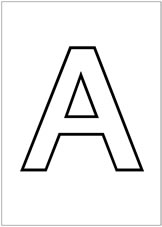
HOLLOW CAPITAL LETTER SHAPES
Capital letter shapes for various art and craft activities.
Reduce size by setting multiples per page on your printer or enlarge to A3 by photocopying if required.
1 sheet of A4

JUMBLED PICTURES AND LETTERS MATCHING GAME
Say the picture‐words and first sounds of the picture‐words. Link to the letter shapes.
You can use this as an A4 paper sheet for your child to make links by pointing to the matching pictures and letters or by drawing lines between the matching pictures and letters.
You can also use this as a poster game – preferably by sticking on card, or printing on card, or laminating – then display on a wall or cupboard door for repeated use. In a pre‐school or school setting, you may want to enlarge this to an A3 poster.
4 sheets of A4
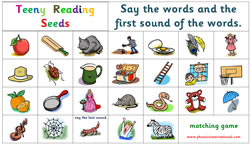

MATCHING LETTERS AND SOUNDS OF KEY PICTURE‐WORDS BOARD GAME
Create a board game by cutting out the letter tiles to place over the matching picture‐words.
Use lower case letter shapes, upper case letter shapes (capital letters), or upper and lower case letters shown together (on each tile) to match the picture‐words.
In a pre‐school or school setting, enlarge to A3 and laminate if possible.
10 sheets of A4

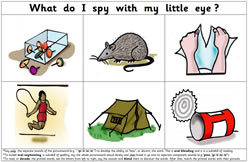
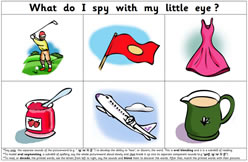
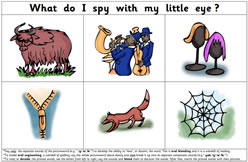
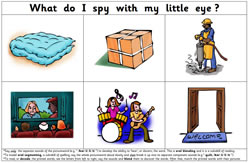
FLEXIBLE PICTURE GAMES – ‘What do I spy with my little eye?’
These pictures can be used in a variety of ways to teach:
i. oral blending (a sub‐skill of reading)
ii. oral segmenting (a sub‐skill of spelling)
Printed words are also provided to model the core skill of:
iii. Model how to sound out and blend printed words – which can then be matched with the pictures.
When children know all their alphabet letters and sounds, they can try sounding out and blending the printed words. Some children can do this easily whilst others take much longer to be able to sound out and blend to ‘hear’, or discern, the words. Model the sub‐skills of oral blending and oral segmenting, and the core skill of sounding out and blending as necessary. Remember to say the sounds as close to real speech as possible, that is “s” not “suh”. The sounds are shown in slash marks like this: /s/ as in snake, /a/ as in apple.
1) Game One: Before referring to the pictures, say the separate sounds of each picture‐word (e.g. “/b/ /e/ /l/ /t/” to develop the ability to ‘hear’, or discern, the word ‘belt’. Can your child ‘hear’ the word from its individual sounds and point to the correct picture? This is oral blending and it is a sub-skill of reading.
2) Game Two: To model oral segmenting, a sub‐skill of spelling, select a picture and say the whole word aloud slowly and then break it up (or segment the spoken word) into its smallest separate component sounds (e.g. “belt, /b/ /e/ /l/ /t/”). Can your child select a picture, say a whole picture‐word aloud slowly and then break it up into its separate sounds?
5 sheets of A4
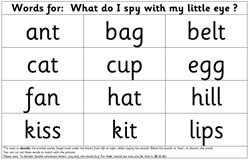
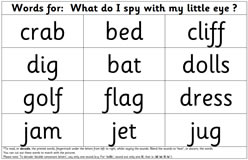
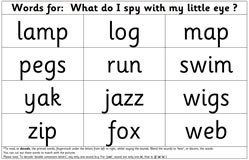
‘What do I spy with my little eye?’ The PRINTED WORDS for sounding out and blending
3) Model how to sound out and blend these printed words. Finger‐track under each letter (or letter group) from left to right whilst saying each sound, then return your finger to the first letter and run your finger under the whole printed word from left to right whilst saying the whole blended word.
When the words have been read (decoded), they can be matched with their picture‐words in the resource above. Once your child has learnt fluently all the alphabet letters and the sounds that they are code for, then he or she can ‘see the letters [or letter groups] and say the sounds’ and blend them to discover the words independently. Suggestions: You can use these pictures as whole sheets and/or you can choose to cut out the pictures and keep them like a pack of cards to select them randomly: and/or you can cut out the words to match them to their pictures.
26 sheets of A4
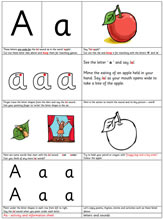
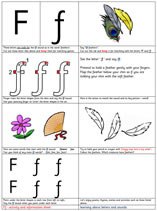
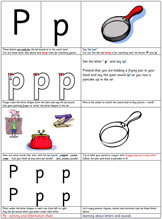
Alphabet letters and sounds ACTIVITY SHEETS and MULTI‐SKILLS SHEETS
– to practise sub‐skills and core skills:
Aa to Zz ACTIVITY SHEETS – With Phonics International ‘actions’ described
These ACTIVITY SHEETS introduce some of the basic sub‐skills of decoding, encoding and handwriting. They are ideal for use either in the home, or in the pre‐school or school setting to then use for repetition and as posters at home.
Choose your own poems, rhymes, stories and creative and topic activities to link with these activity sheets. See the suggestions in the planning section above.
Please note that these sheets are the same as the Activity Sheets described below except these sheets also include the ‘actions’.
26 sheets of A4
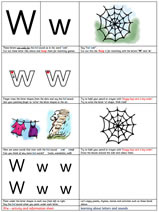
Aa to Zz ACTIVITY SHEETS – With no ‘actions’ described
These ACTIVITY SHEETS introduce some of the basic sub‐skills of decoding, encoding and handwriting. They are ideal for use either in the home, or in the pre‐school or school setting to then use for repetition and as posters at home.
Choose your own poems, rhymes, stories and creative and topic activities to link with these activity sheets. See the suggestions in the planning section above.
29 sheets of A4

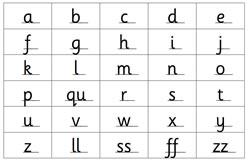

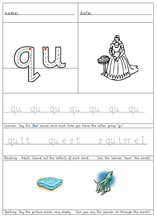
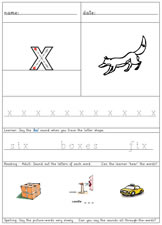
TEENY READING SEEDS MULTI‐SKILLS SHEETS
These MULTI‐SKILLS SHEETS go a step further than the ACTIVITY SHEETS by practising not only the sub‐skills of reading (decoding) and spelling (encoding) but also the core skills. Guidance and a selection of grapheme tiles with letters on writing lines are also provided for extension activities.
If these sheets are used at an early stage of learning, the adult provides the modelling throughout the sheets, but if the sheets are used, or re‐visited, when children have had plenty of experience with letters and sounds, and the sub-skills and core skills of reading, spelling and handwriting, then the children will be able to complete these sheets with greater independence.
The MULTI‐SKILLS SHEETS can be used in any order as they are not cumulative, and they can also be used as posters for visual display for children to access and re‐visit. When used as posters in a pre‐school or school, print on card or laminate if possible and display low enough for children to be able to interact with the activities.
The MULTI‐SKILLS SHEETS are excellent for practising letter formation of the lower case letter shapes – therefore supplement the teaching of handwriting even when children have begun a systematic synthetic phonics programme.
31 sheets of A4
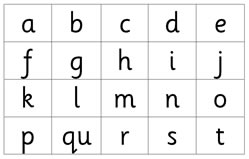
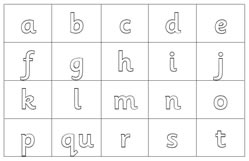

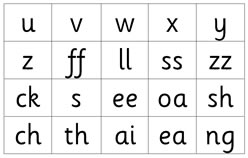
SELECTION OF GRAPHEME TILES
Various Grapheme Tiles allow you to select and use as preferred. Some of these might be cut out and glued into your child’s phonics book. They could be printed on card or laminated then cut out for blending and segmenting activities. Some common letter groups are included for incidental phonics teaching.
Phonics and Talk Time Books 1 and 2 (PDF downloads)
